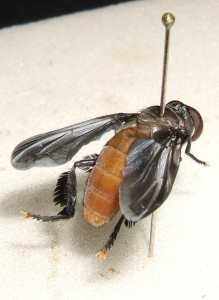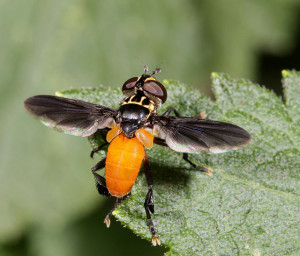Master Gardener and Entomology Specialist, Donya Camp, took this picture the other day. It occurred to me that it would make the perfect “interesting insect” to feature today, not only because of it’s holiday colors, but also because of it’s importance to the pumpkin and squash patch.
Trichopoda pennipes may be one of the prettiest flies in the family Tachinidae. Any fly enthusiast will tell you that tachinid flies are best known for their highly useful skills at stalking and attacking pests. Trichopoda pennipes lays its eggs on the bodies of squash bugs and green stink bugs. About the size of a small horse fly, this insect may be found hovering over squash plants in the summer, looking for prey.
Research has shown that Trichopoda flies play a trick on their stink bug prey. Sex pheromones used by green stink bugs to attract mates are used by the fly to hone in on their prey. This tactic results in decreased life spans and fecundity of the stink bug.
According to Huffman and Frodsham’s book, Natural Enemies of Vegetable Insect Pests, up to 80% of squash bugs in gardens may be parasitized by Trichopoda flies. Unfortunately, the authors note, that this doesn’t always translate into good pest control. It turns out that squash bugs continue to live for some time after being parasitized, sometimes allowing damage to occur before the squash bug dies.
Despite its shortcomings, this is a cool insect to have around. They are very attractive (if you get close enough to look and photograph them) and serve as great revenge on pesky squash bugs, even if they don’t completely protect your plants. To see whether the flies are at work in your garden, collect adult squash bugs and look on their undersides. If they have been parasitized you should be able to see some white, oval-shaped eggs on the bug’s undersides.
If you want to see more of these flies in your vegetable garden, consider planting plants to attract and feed the adult flies. Attractive plants for tachnid flies include those with extrafloral nectaries or with shallow corollas, such as plants in the family Umbelliferae (carrot, dill, parsley, yarrow, etc.). Also, keep in mind that many pesticides are toxic to Trichopoda. Any of the pyrethroid insecticides, and even spinosad (an organic insecticide), have been shown to kill this beneficial insect.
Thanks to Donya for use of the picture. Also, for more information about how to use plants to attract beneficials to your garden, see the excellent fact sheets on this subject from Michigan State University.

